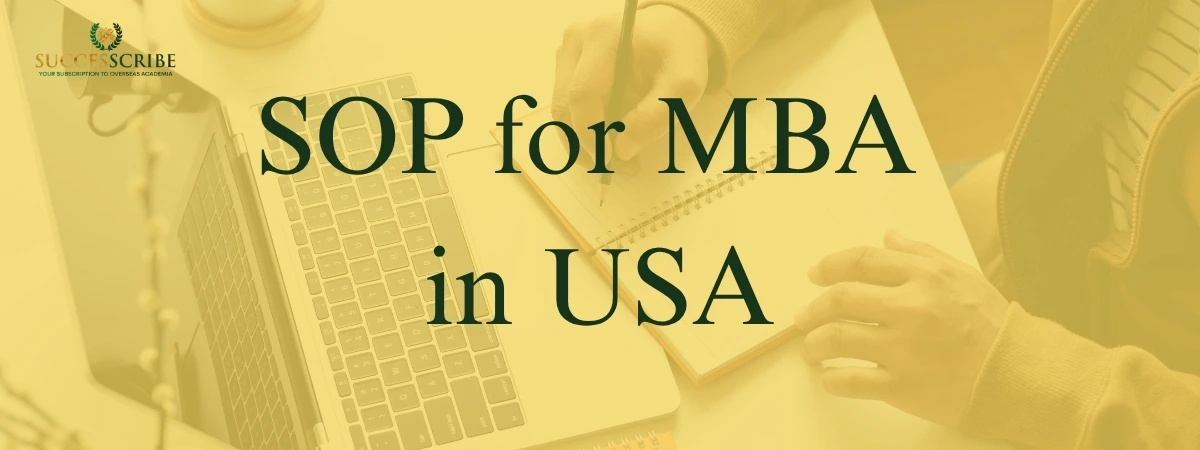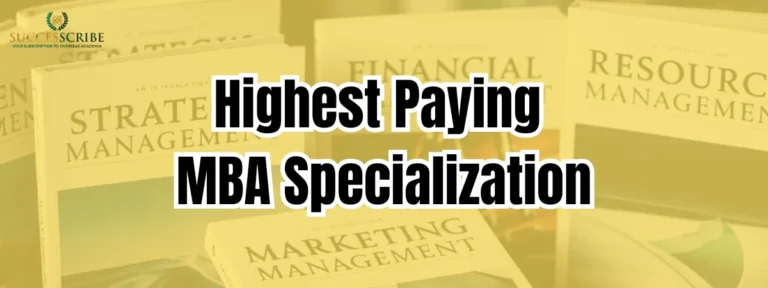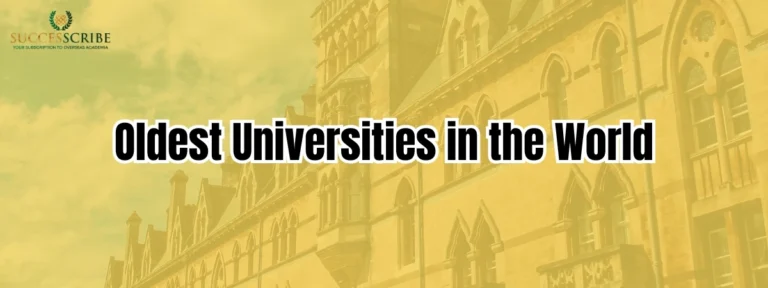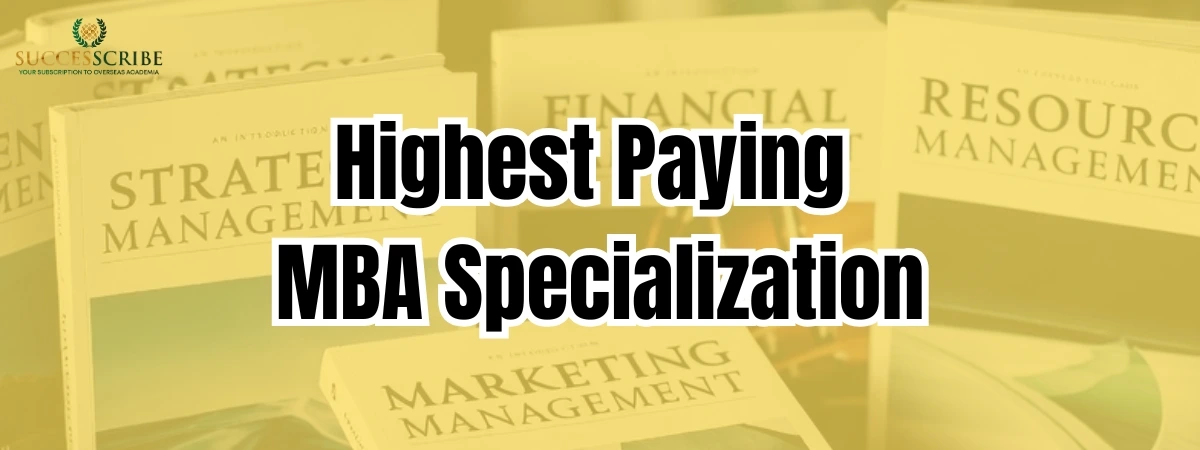Pursuing an MBA in the USA is a dream for many students due to the country’s world-class business schools, diverse culture, and excellent career opportunities.
It is a personal essay that provides admissions committees with insights into your academic background, professional experience, career goals, and motivation for pursuing an MBA. The SOP goes beyond the resume and transcripts, allowing you to present a compelling narrative about who you are, what drives you, and how the MBA program aligns with your future aspirations. With the U.S. being home to prestigious institutions like Harvard, Stanford, and Wharton, a well-structured SOP for MBA in USA can set you apart in a competitive admissions process.
The SOP not only helps the admission committee assess your suitability for the program but also reflects your communication skills, clarity of thought, and your potential to contribute to the cohort.
Sample SOP for MBA in USA
From managing teams in dynamic tech environments to leading strategic digital transformation initiatives, I have developed a deep appreciation for how innovation drives business success. With five years of experience as a software engineer at Infosys and a passion for leadership, I seek to pivot into a strategic consulting role with a global impact. To bridge the gap between my technical foundation and strategic acumen, I am applying to the MBA program at the University of Michigan Ross School of Business.
During my undergraduate studies in Computer Science at Delhi Technological University, I cultivated strong analytical and problem-solving abilities, graduating with honors. My final-year capstone project—developing an AI-powered sentiment analysis tool—ignited my interest in leveraging technology to improve decision-making in business contexts.
At Infosys, I quickly moved from an entry-level engineer to a team lead on a digital transformation project for a major retail client. I led a cross-functional team of 12 people, collaborated with stakeholders across three continents, and helped the client reduce operational costs by 25%. This role honed my leadership, communication, and project management skills. I also initiated a mentorship program within the department that improved junior employee retention by 18%.
I now aspire to become a management consultant at a firm like Bain & Company, specializing in digital strategy. In the long run, I aim to return to India and launch a tech-focused consulting firm that supports SMEs in their digital growth journey.
Ross School of Business stands out for its action-based learning, commitment to diversity, and strong alumni network. I am particularly excited to participate in MAP (Multidisciplinary Action Projects) and learn from professors like Venkat Ramaswamy. I believe Ross will offer me the perfect platform to grow into a globally competent, socially responsible business leader.
Suggested post: Best states in USA for International students
Standard SOP Structure for MBA in USA
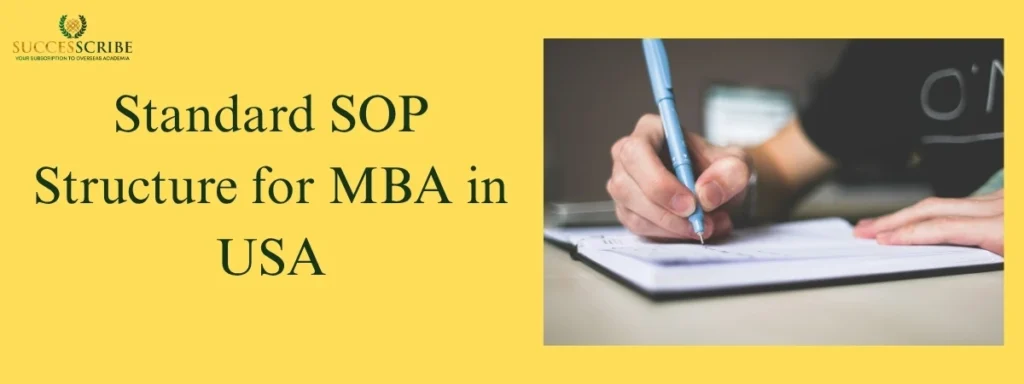
The SOP for MBA in USA serves as a personal narrative that complements your academic transcripts and resume. Unlike other documents, it allows you to Demonstrate your personality and leadership qualities, Explain career transitions, Highlight unique experiences that don’t fit into a resume, showcase your research about the program and school fit.
| Section | Purpose |
| Introduction | Introduce yourself and state your motivation for an MBA |
| Academic Background | Highlight your educational qualifications |
| Professional Experience | Detail your work history and accomplishments |
| Career Goals | Outline your short-term and long-term goals |
| Why This MBA Program | Explain why you chose the specific university |
| Conclusion | Reaffirm your commitment and readiness for the MBA journey |
1. Crafting the Introduction (Approx. 300 Words)
The introduction sets the tone for your SOP. Begin with a powerful opening that grabs the attention of the reader. You can start with an anecdote, a personal story, or a statement that reflects your passion for business and leadership. Briefly introduce your academic and professional background and state your intent to pursue an MBA in the U.S.
Example Opening:
Standing at the intersection of technology and management, I have often found myself asking how innovation can be effectively scaled to deliver strategic business value. This question, which first surfaced during my tenure as a software engineer at XYZ Technologies, has become the driving force behind my decision to pursue an MBA in the United States.
2. Highlighting Academic Background (Approx. 400 Words)
Discuss your undergraduate education, major, university, and key academic achievements. Highlight any projects, papers, or coursework relevant to business or management. If your background is non-business, show how your education still equips you with analytical and problem-solving skills.
Example:
I completed my Bachelor of Technology in Electronics and Communication Engineering from ABC University, graduating with a GPA of 3.8/4.0. During this time, I developed a keen interest in analytics and decision-making models, completing projects such as…
3. Showcasing Professional Experience (Approx. 700 Words)
This is one of the most crucial parts of your SOP. Detail your work experience, roles, responsibilities, and accomplishments. Use quantifiable metrics to show your impact. Demonstrate leadership, collaboration, problem-solving, and innovation.
Example:
Over the past four years at XYZ Technologies, I have progressed from a junior analyst to a project lead, managing cross-functional teams across three continents. One of my proudest achievements was leading a product optimization project that resulted in a 30% increase in customer retention.
4. Stating Career Goals (Approx. 500 Words)
Be specific and realistic about your short-term and long-term career objectives. Explain how the MBA will help you bridge the gap between where you are and where you want to be. Align your goals with the business school’s offerings.
Example:
In the short term, I aim to transition into a strategy consultant role with a top-tier firm such as McKinsey or BCG. Long-term, I envision leveraging this experience to become a Chief Strategy Officer in a tech-driven multinational organization. An MBA will provide me with the strategic acumen, leadership training, and global exposure required to achieve these goals.
5. Why This MBA Program (Approx. 500 Words)
Demonstrate that you’ve done your research. Mention specific courses, professors, clubs, and values that resonate with you. Explain why the school is the right fit for you and how you are a good fit for them.
Example:
The University of Chicago Booth’s emphasis on data-driven decision-making and its flexible curriculum make it an ideal place for someone with my technical background. I am particularly excited about Professor Austan Goolsbee’s course on Business Strategy and the opportunity to participate in the Booth Technology Group.
| University Element | Why It Matters to Me |
| Flexible Curriculum | Allows customization to match my goals |
| Alumni Network | Provides access to mentors and career opportunities |
| Experiential Learning | Enhances real-world problem-solving skills |
6. Conclusion (Approx. 300 Words)
End with a strong conclusion that reiterates your goals, readiness, and enthusiasm. Leave the reader with a confident impression of your candidacy.
Example:
With a strong foundation in technology, significant industry experience, and a clear vision for the future, I am confident that I will thrive in the rigorous and collaborative environment at your MBA program. I look forward to contributing to and growing within your esteemed community.
Suggested Post: Best place to study in USA
Common SOP Mistakes and How to Avoid Them

Even the most promising candidates can falter if their Statement of Purpose is riddled with common mistakes. A well-crafted SOP can be a game-changer in your MBA application, while avoidable errors can significantly reduce your chances of admission. Avoiding generic statements and lack of school-specific details can significantly improve the effectiveness of your SOP for MBA in USA. Here’s a deeper look into the most prevalent pitfalls and how to prevent them:
| Mistake | Fix |
| Generic SOP | Customize for each program |
| Cliché Phrases | Use specific, personal stories |
| Vague Goals | Define clear short-term and long-term objectives |
| Resume Repetition | Tell a narrative, not a list |
| Grammar Errors | Proofread and edit thoroughly |
| Ignoring School Fit | Mention specific aspects of the program |
| Incorrect Length | Stay within 1000-1500 words |
- Lack of Personalization
Many applicants use a generic SOP for all the universities they apply to. Admissions committees can easily identify these and are likely to reject such applications. Each SOP should reflect your deep understanding of the program, including specific courses, faculty, values, or campus initiatives that resonate with your profile.
- Overuse of Clichés
Phrases like “Since childhood I’ve been interested in business” or “I want to make the world a better place” are too broad and unoriginal. Use authentic stories and personal experiences to showcase your motivations.
- Weak Career Goals
Some applicants write vague statements like “I want to be successful in business.” Admissions teams are looking for candidates with clear, well-researched, and attainable career objectives. Mention roles, industries, or even companies you aspire to work with.
- Repetition of Resume
An SOP is not a chronological restatement of your CV. Instead, it should be a cohesive narrative that ties your experiences together with reflection and purpose.
- Grammatical and Spelling Errors
Silly mistakes can undermine your professionalism. Always proofread your SOP multiple times. Use tools like Grammarly or seek feedback from mentors or consultants.
- Failure to Show Fit
Some SOPs focus only on the applicant without referencing the school. Make it clear why you’ve chosen that particular MBA program and how it complements your goals.
- Too Long or Too Short
Respect the word limit provided by the university. Generally, 1000 to 1500 words is the sweet spot. Avoid being too brief or overly verbose.
- Lack of Storytelling
A list of achievements isn’t enough. Use storytelling techniques to present challenges, decisions, and turning points in your life that led you to pursue an MBA.
Suggested Post: Duolingo accepting universities in USA
How to Tailor SOPs for Different MBA Specializations

When writing your SOP for an MBA program, it’s essential to tailor it according to the specialization you’re applying for. A one-size-fits-all approach doesn’t work for competitive MBA admissions. Each specialization, whether in Finance, Marketing, Entrepreneurship, or Technology, demands a different set of skills, aspirations, and experiences, which should be reflected clearly in your statement of purpose. A tailored SOP for MBA in USA can vary depending on whether you are pursuing Finance, Marketing, Entrepreneurship, or Technology Management. A customized SOP helps the admissions committee understand how your past experiences, current motivations, and future goals align with the chosen concentration. Below is a breakdown of how to approach SOP writing for popular MBA specializations:
Key Elements to Highlight by Specialization
| MBA Specialization | What to Emphasize in SOP |
| Finance | Quantitative aptitude, financial analysis skills, data interpretation, internships in banks or finance-related roles, CFA studies, interest in financial markets. |
| Marketing | Creativity, brand awareness, digital marketing experience, understanding of consumer behavior, successful marketing campaigns, storytelling, and communication skills. |
| Entrepreneurship | Innovation mindset, previous startup experience or leadership in new initiatives, risk-taking ability, vision for launching ventures, passion for solving real problems. |
| Technology Management | Blend of technical and managerial skills, experience in IT or engineering, project management, interest in tech innovation and digital transformation. |
| Human Resources | People management, emotional intelligence, organizational behavior understanding, team leadership, interest in workplace culture and talent development. |
| International Business | Global outlook, cross-cultural experiences, multilingual ability, internships abroad or in MNCs, interest in global strategy and international markets. |
| Operations Management | Efficiency, process optimization, supply chain exposure, Six Sigma or lean management experience, logistics understanding, data-driven decision-making. |
Suggested Post: Engineering management courses in USA
Sample Customization Snippets
- For MBA in Finance:
My internship with HSBC introduced me to the fast-paced world of investment banking. I now seek to deepen my understanding of financial modeling and risk analysis through a finance-focused MBA.
- For MBA in Marketing:
While working on a rebranding campaign for a lifestyle brand, I discovered my passion for market research and consumer behavior, pushing me to pursue an MBA in Marketing.
- For MBA in Entrepreneurship:
Having co-founded a tech-based food delivery startup during college, I understand both the thrill and challenge of building something from scratch. I now seek academic grounding to scale future ventures.
Conclusion
Writing a winning SOP for MBA in USA requires clarity, authenticity, and strategic storytelling. By following this guide, avoiding common mistakes, and tailoring your essay to each school, you can significantly boost your chances of admission.
Start drafting early, seek feedback, and ensure your SOP reflects your unique journey and ambitions. With a compelling SOP, you can turn your MBA dream into reality!
FAQs
How long should an SOP for MBA in USA be?
Most U.S. business schools prefer SOPs that are between 1000 to 1500 words or about 1 to 2 pages, depending on spacing and formatting. Always check each university’s specific word limit or formatting requirements before submission.
Can I use the same SOP for every university I apply to?
No, using the same SOP is a common mistake. Each SOP should be tailored to reflect the values, curriculum, and strengths of the specific university. Mention faculty, courses, or unique features that show you’ve done your research.
Should I mention my specialization in the SOP?
Yes. If you have a preferred concentration such as Finance, Marketing, or Entrepreneurship, it’s a good idea to explain why you chose it and how it aligns with your career goals. It helps the admissions team understand your academic focus and future direction.
Can I talk about changing careers in my SOP?
Absolutely. In fact, an MBA is often pursued for career transition. Just ensure you explain the rationale behind the shift, how your past experiences have led you to this decision, and how an MBA bridges the gap between your past and future.
Should I address a low GPA or career gap in the SOP?
If the university hasn’t provided a separate “optional essay” for this, you can briefly address academic or professional shortcomings in your SOP. Focus on how you overcame them and what you learned, rather than justifying them.
Related Post
Scholarships for bachelors in USA
Scholarships for Masters in USA
Scholarships for Indian students to study in USA
Scholarship for Phd in USA for Indian students

